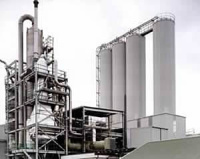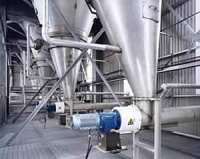Dehumidifiers in Silo
Most materials stored in silos are affected by high air humidity or moisture regain. Problems include irregular flow, agglomeration, increased microbial activity, chemical reaction with moisture and general degradation of the stored product.
Temperature changes to the silo and moisture laden head space air cause the relative humidity to fluctuate. At lower temperatures the relative humidity of the head space air will increase, often to saturation point (100%RH) when the air begins to deposit moisture on internal surfaces of the silo. These problems can be eliminated by ensuring that air in the head space is maintained at a low relative humidity. A dry air circulation rate of 1 x silo volume per hour is normally sufficient.

The simplest solution is to install the dehumidifier in the base of the silo skirt. Dehumidified fresh air is then ducted into the filling line or a separate pipe leading to the head space. This system creates a slight positive pressure which opposes the natural tendency of moisture to diffuse through the silo structure due to differences in vapour pressure. Excess air pressure is exhausted through the vent filter assembly on top of the silo. During filling, the dehumidifier”s dry air supply duct must be isolated.
A dehumidified air re-circulation system is normally only recommended when a very low humidity or dewpoint is required in the silo (e.g. storage of PLA, polylactic acid). Dust from some stored materials can be drawn into the air return line. This can potentially cause damage to the dehumidifier so additional air filtration modules may be necessary.
Dehumidifying the air void above the product is often sufficient to maintain a low humidity condition throughout the silo. Any moisture contained in the air surrounding the material granules quickly migrates to the lower vapour pressure of the dry air in the head space (Dalton’s law). Therefore, it is not usually necessary to inject dry air into the base of the silo.
